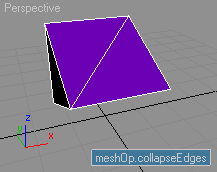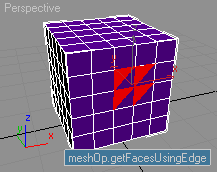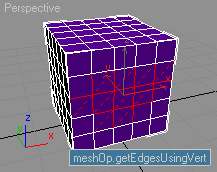Meshop Edge Methods
The following methods exposed by the meshOp Struct provide advanced access to the mesh edges.
- Chamfer, Extrude, Collapse Edges
- Clone and Delete Edges
- Divide Edges
- Get A Using B...
- AutoEdge Visibility
Methods:
Chamfer, Extrude, Collapse Edges
meshop.chamferEdges <Mesh mesh> <edgelist> <float amount>
Chamfers the specified edges by the specified amount.
EXAMPLE
obj = Box() convertToMesh obj meshop.chamferEdges obj #{7,8,11,14,17} 5 update obj
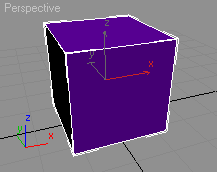
meshop.extrudeEdges<Mesh mesh> <edgelist> <float height> dir:<{<point3 dir> | #independent | #common}=#independent> node:<node=unsupplied> Creates new edges corresponding to the specified edges, and then moves the new edges by <height>.
The direction the edges are moved is determined by <dir>. If <dir> is a point3 value, the edges will be moved in that direction. (If <mesh> is a node, or if <mesh> is an Editable Mesh or a Mesh value and node: is specified, the direction is in the current coordinate system context. If <mesh> is an Editable Mesh or a Mesh value and node: is not specified, the direction is in the mesh's local coordinate system.)
If dir:#independent is specified, the edges are moved based on the normals of the faces using the edge. If dir:#common is specified, the edges are moved based on the normals of the face clusters using the edge.
EXAMPLE
obj = Box() --create a Box convertToMesh obj --collapse to EMesh meshop.extrudeEdges obj #{5,7,14,17} 10.0 --extrude edges update obj --update the mesh addmodifier obj (normalmodifier unify:true) --unify normals addmodifier obj (smooth auto:true) --auto-smooth convertToMesh obj --collapse to EMesh

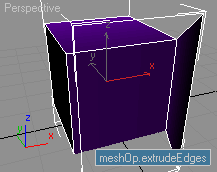
meshop.collapseEdges <Mesh mesh> <edgelist> Collapses the specified edges.
EXAMPLE
obj = Box() convertToMesh obj meshop.collapseEdges obj #{14,17} update obj

Clone and Delete Edges
meshop.cloneEdges <Mesh mesh> <edgelist> Clones the specified edges.
meshop.deleteEdges <Mesh mesh> <edgelist> delIsoVerts:<boolean=true> Deletes the specified edges.
If delIsoVerts: is true , any isolated vertices are deleted.
Divide Edges
meshop.divideEdge <Mesh mesh> <int edgeIndex> <float edgef> visDiag1:<boolean=false> visDiag2:<boolean=false> fixNeighbors:<boolean=true> split:<boolean=false> Divides the specified edge at a fractional distance of <edgef> along its length.
visDiag1: and visDiag2: specify whether each of the two new edges will be visible.
If fixNeighbors: is true , the face on the other side of this edge, that is, the "reverse face", should be divided as well to prevent the introduction of a seam.
If split: is true , separate vertices for the two halves of the edge will be created, splitting the mesh open along the diagonal(s).
EXAMPLE
obj = Box() --create a Box convertToMesh obj --collapse to EMesh meshop.divideEdge obj 5 0.33 --divide bottom edge at 1/3 meshop.divideEdge obj 5 0.5 --divide remaining 2/3 at half -> 2 * 1/3 update obj --update the mesh obj.vertexTicks = True --show the vertices obj.allEdges=True --show all edges

meshop.divideEdges <Mesh mesh> <edgelist> Divides all the specified edges in half, creating new points and subdividing faces.
EXAMPLE
obj = Box() --create a Box convertToMesh obj --collapse to EMesh meshop.divideEdges obj #{5,7,14,17} --divide edges update obj --update the mesh obj.vertexTicks = True --show the vertices obj.allEdges=True --show all edges

meshop.edgeTessellate <Mesh mesh> <facelist> <float tension> Tessellates the specified edges. This algorithm is exactly the one used in the Tessellate modifier, when operating on Faces and Edge SO elements.
<tension> specifies the tension for the edge tessellation. This value should be fairly small, between 0 and .5, and corresponds to the value in the Tessellate, Edit Mesh, or Editable Mesh UI's divided by 400.
EXAMPLE
obj = Box() --create a Box convertToMesh obj --collapse to EMesh meshop.EdgeTessellate obj #{5,6} 0.0 --tessellate faces based on edges update obj --update the mesh

meshop.turnEdge <Mesh mesh> <int edgeIndex> Turns the specified edge. Only works on edges that have a face on both sides. These two faces are considered as a quad, where this edge is the diagonal, and remapped so that the diagonal flows the other way, between the vertices that were opposite this edge on each face.
Get A Using B...
meshop.getVertsUsingEdge <Mesh mesh> <edgelist> Returns a bitarray of size=(#vertices in mesh) with bits set for all vertices that are used by the specified edges.
SCRIPT
macroScript Edge2VertSel category:"MXS Help" ( --make sure a single EMesh object is selected on isEnabled return selection.count == 1 and classof selection[1] == Editable_Mesh on execute do ( obj = selection[1]--get selected object edgeSel = getEdgeSelection obj --get selected Edges --get Verts of selected Edges: vertsSel = meshop.getVertsUsingEdge obj edgeSel setVertSelection obj vertsSel --select the Verts max modify mode --switch to Modify panel subObjectLevel =1--set Vertex SO level ) --end on ) --end macro

meshop.getFacesUsingEdge <Mesh mesh> <edgelist> Returns a bitarray of size=(#faces in mesh) with bits set for all faces that use the specified edges.
SCRIPT
macroScript Edge2FaceSel category:"MXS Help" ( --make sure a single EMesh object is selected on isEnabled return selection.count == 1 and classof selection[1] == Editable_Mesh on execute do ( obj = selection[1] --get selected object edgeSel = getEdgeSelection obj --get selected Edges --get Faces of selected Edges: faceSel = meshop.getFacesUsingEdge obj edgeSel setFaceSelection obj faceSel --select the Faces maxmodify mode --switch to Modify panel subObjectLevel =3 --set Face SO level ) --end on ) --end macro

meshop.getPolysUsingEdge <Mesh mesh> <edgelist> ignoreVisEdges:<boolean=false> threshhold:<float=45.> Returns a bitarray of size equal to the number of faces in mesh with bits set for all faces that are in 'polygons' containing the specified edges.
The definition of a polygon is all faces sharing invisible edges with edge angles below the threshhold angle. The default threshhold angle is 45 degrees.
If ignoreVisEdges: is set to true , the edge visibility is ignored but the threshhold is still relevant.
SCRIPT
macroScript Edge2PolySel category:"MXS Help" ( --make sure a single EMesh object is selected on isEnabled return selection.count == 1 and classof selection[1] == Editable_Mesh on execute do ( obj = selection[1] --get selected object edgeSel = getEdgeSelection obj --get selected Edges --get Polygons of selected Edges: faceSel = meshop.getPolysUsingEdge obj edgeSel setFaceSelection obj faceSel --select the Faces max modify mode --switch to Modify panel subObjectLevel =4 --set Polygon SO level ) --end on ) --end macro

meshop.getEdgesUsingVert <Mesh mesh> <vertlist> Returns a bitarray of size=(#edges in mesh) with bits set for all edges that use the specified vertices.
SCRIPT
macroScript Vert2EdgeSel category:"MXS Help" ( --make sure a single EMesh object is selected on isEnabled return selection.count == 1 and classof selection[1] == Editable_Mesh on execute do ( obj = selection[1] --get selected object vertsSel = getVertSelection obj --get selected Verts --get Edges of selected Verts: edgeSel = meshop.getEdgesUsingVert obj vertsSel setEdgeSelection obj edgeSel --select the edges max modify mode --switch to Modify panel subObjectLevel =2 --set Edge SO level ) ) --end macro
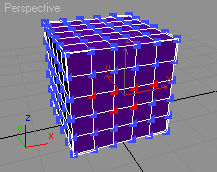
meshop.getEdgesReverseEdge <Mesh mesh> <edgelist> Returns a bitarray of size=(#edges in mesh) with bits set for all additional edges that use the same vertices as the specified edges. These are edges on the adjacent faces.
EXAMPLE
Plane length:100 width:100 isSelected:on convertTo $ TriMeshGeometry max modify mode subobjectLevel = 1 select $.verts[13] --get edges that use vertex 13 edges = meshop.getEdgesUsingVert $ (getVertSelection $) --select the vertices used by those edges $.selectedVerts = meshop.getVertsUsingEdge $ edges update $ --not what we wanted, really want all vertices -- "surrounding" vertex 13 faces = meshop.getPolysUsingVert $ 13 $.selectedVerts = meshop.getVertsUsingFace $ faces update $ --or ... faces = meshop.getFacesUsingVert $ #(13) edges = meshop.getEdgesUsingFace $ faces --turn off all visible edges for e in edges do edges[e]=not (getEdgeVis $ (1+(e-1)/3)(1+mod (e-1) 3)) --get the edges on the adjacent faces that are the "reverse" of these edges --"OR" that bitarray with the initial edges bitarray edges = (meshop.getEdgesReverseEdge $ edges) + edges --get the faces that use the edges, and "OR" that bitarray with the initial --face bitarray faces = (meshop.getFacesUsingEdge $ edges) + faces $.selectedVerts = meshop.getVertsUsingFace $ faces update $
meshop.getOpenEdges <Mesh mesh> Returns a bitarray of size=(#edges in mesh ) with bits set for all edges that are used by a single face.
SCRIPT
macroScript SelOpenEdges category:"MXS Help" ( --make sure a single EMesh object is selected on isEnabled return selection.count == 1 and classof selection[1] == Editable_Mesh on execute do ( obj = selection[1] --get selected object max modify mode --switch to Modify panel subObjectLevel =2 --set Edge SO level openEdges = meshop.getOpenEdges obj --get open edges setEdgeSelection obj openEdges --select the open edges ) ) --end macro
AutoEdge Visibility
meshop.autoEdge <Mesh mesh> <edgelist> <float threshold> type:<{#SetClear| #Set| #Clear}=#SetClear> Sets/clears the edge visibility for the specified edges based on the threshold angle.
For an edge to be autoEdged, both it and the "reverse" edge on the face sharing the same vertices must be specified in the edge specification.
For more mesh-related methods, see


